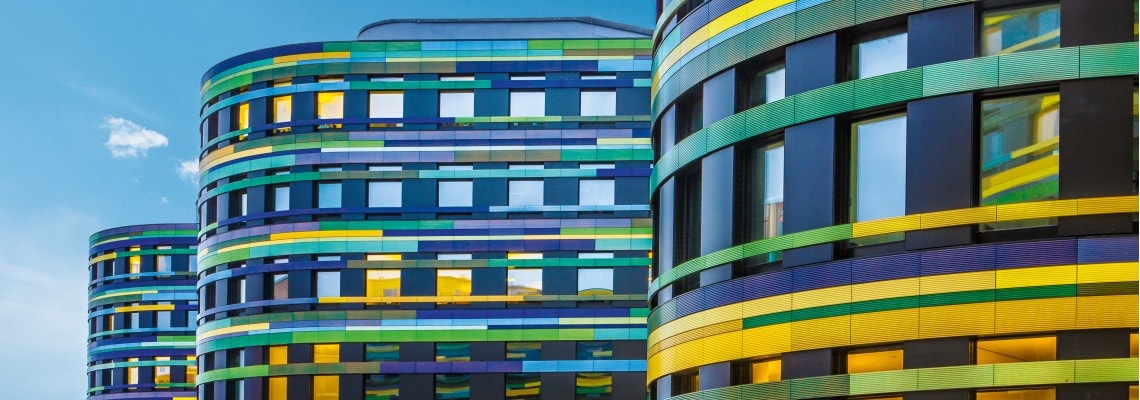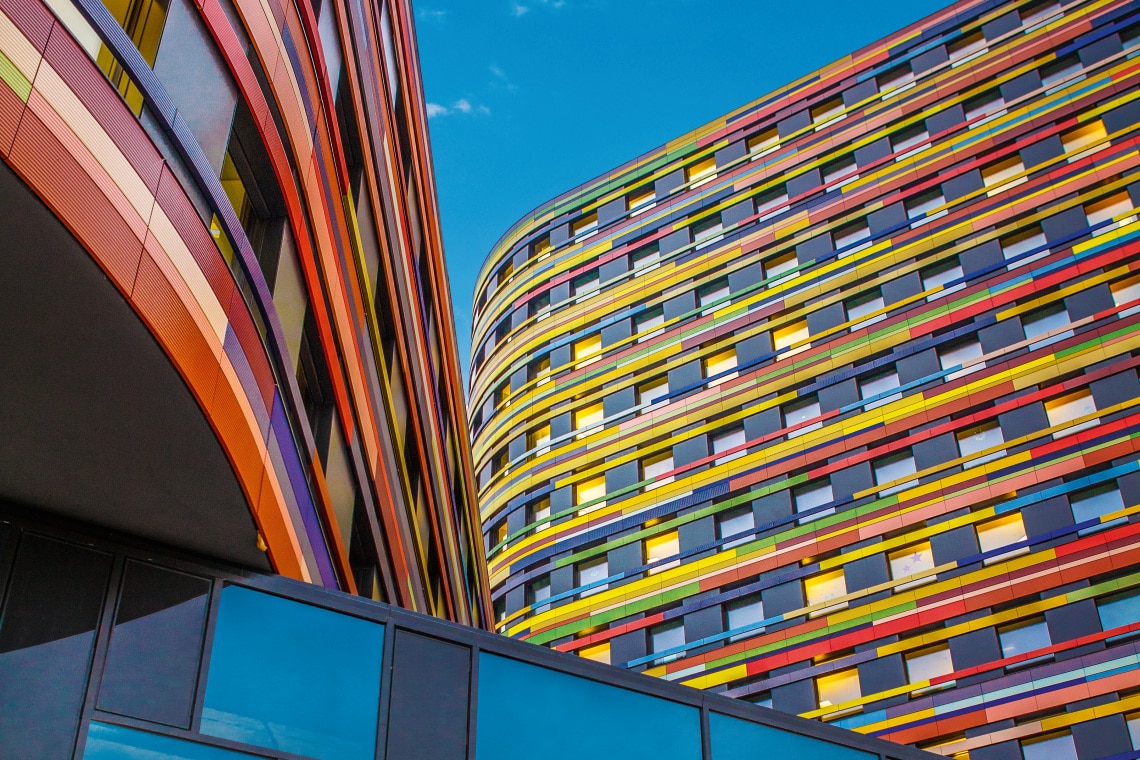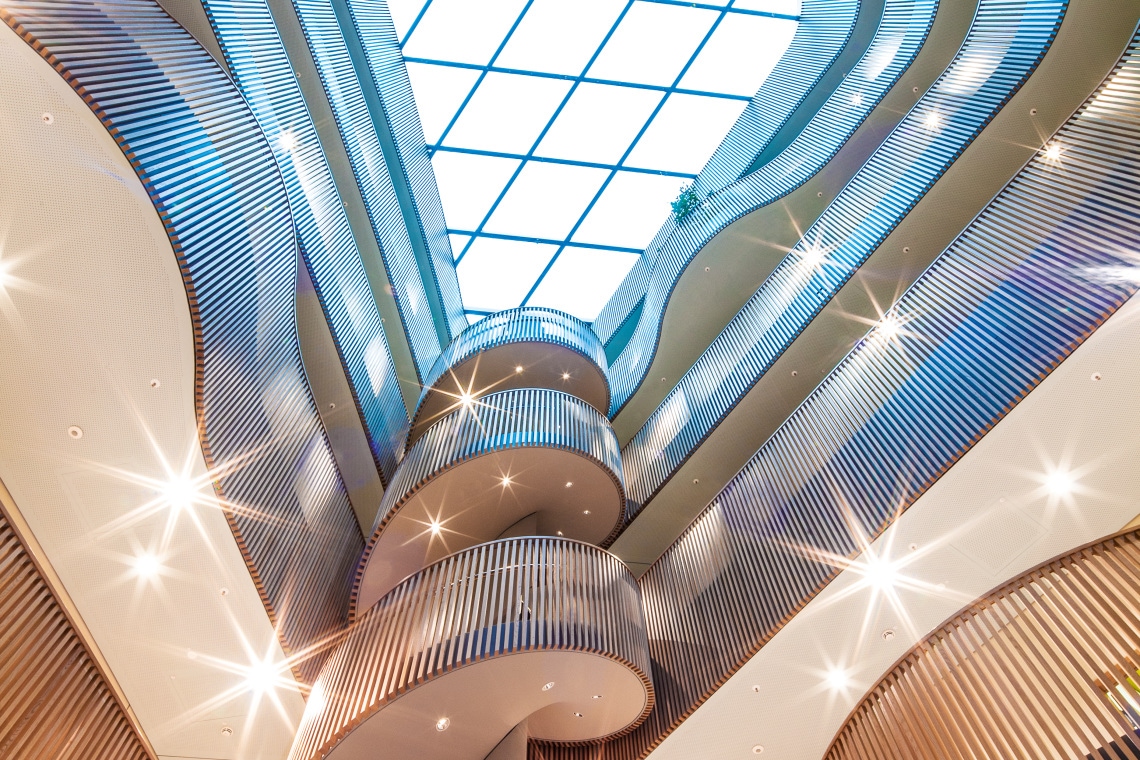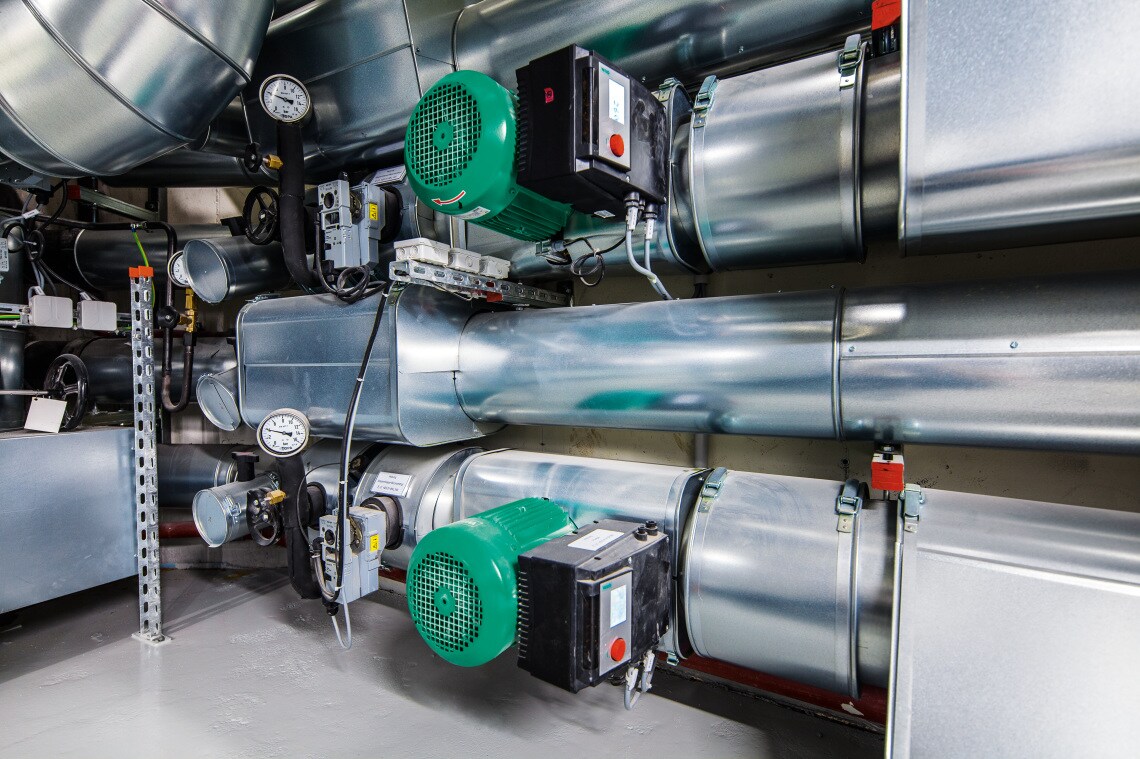
New buildings for the German Department for Urban Development and the Environment (BSU):
After its vibrant, eye-catching façade, the most striking aspect of the headquarters of the Department for Urban Development and the Environment (BSU) in Hamburg is the use of geothermal energy, combined with thermoactive ceilings and a sophisticated ventilation system. Wilo high-efficiency pump technology also plays a central role in environmentally-friendly heating, cooling and water supply.
Almost 1,500 employees of the Agency for Geoinformation and Surveying (LGV) work here across a gross floor area of just over 61,000 m2.The multi-faceted building is not only visually impressive, it also meets the most stringent ecological requirements and is considered to be one of the most energy-efficient office buildings in Germany. As a result, the new building was awarded an ‘Excellence Pass’ by the Hamburg International Building Exhibition (IBA) and has received a Gold Certificate from the German Sustainable Building Council (DGNB).“The excellent building standard is based on a comprehensive energy concept consisting of an effective combination of renewable energies and thorough application of passive house criteria,” explained Axel Hupfeld, Project Manager at Obermeyer Planen + Beraten GmbH. The annual primary energy requirements of a mere 58.13 kWh/m2·a are far below the developer’s original specifications of 70 kWh/m2·a. And, when it comes to heating requirements, the building is also below the required upper limit of 15 kWh/m2·a, and therefore meets passive house standards.

The Department of Urban Development and the Environment (BSU) is one of the most energy-efficient office buildings in Germany.
Geothermal energy as the basis of a sustainable energy concept
A renewable energy source, geothermal energy forms the basis of the building’s energy concepts, as thermoactive ceilings regulate room temperature. Furthermore, environmentally-friendly operation of the heating and cooling systems and a reliable water supply are ensured by the Wilo high-efficiency pump technology.The building rests on a total of 1,640 bored piles each measuring 19 metres in length. Half of these are used to transfer geothermal energy (average source temperature: 13 °C). Two brine/water heat pumps provide the building with hot water at a feed temperature of 50 °C through a brine circuit.The heat pumps undertake the base load. These are powered with green energy from Hamburg Energie which provides local heat to cover peak loads. Therefore, the heat pumps and local heat can cover the building’s heating load, even if outdoor temperature falls to -12 °C. The bivalent concept also enables replenishment from the local heat network if one geothermal field fails or is depleted. “We prevent a possible depletion of the geothermal field by balancing out the heat we extract in winter with heat discharged from the building in summertime, which we transfer into the ground,” explained Jörn Delicat, Consultant at Obermeyer GmbH responsible for the project.
Two-stage cooling in summer months
The cooling system is composed firstly of two cooling towers located on the roofs, and secondly of the geothermal field in instances where the external air temperature no longer permits use of the heat exchangers.Electronically controlled Wilo in-line pumps ensure reliable and energy-efficient operation of the heating and cooling circuits: the cooling side features CronoTwin-DL-E double pumps, while the brine and heating circuits have VeroLine-IP-E in-line pumps, which are also installed in the heat exchangers’ glycol circuit. Integrated electronic power adjustment for the glanded pumps provides high levels of energy efficiency.
Thermoactive ceilings for heating and cooling
Two buffers, each with a capacity of 5,000 litres, regulate room temperature. From there, the water is distributed to the different buildings with their separate heating and cooling circuits for the thermoactive ceilings over a total surface area of 22,000 m2.The system temperatures of the five-storey building sections are 49 °C/28 °C (heating) and 14 °C/22 °C (cooling), while VeroLine-IP-E in-line pumps manage their circulation. By contrast, the high rise building’s thermoactive ceilings operate with feed and return temperatures of 32°C/28°C (heating) and 18°C/22°C (cooling). This results in a constant ∆T of 4 K, meaning that the same mass flow is required in each case, which removes the need for an otherwise necessary duty point switchover. Two Wilo-Stratos high-efficiency pumps provide a maximum volume flow of approximately 30 m3/h.In the few areas without thermoactive ceilings, convectors, underfloor heating and static heating surfaces are used. In winter, the heating batteries of the central ventilation units also have to be supplied to reheat the outside air. The associated heating circuits feature a further seven
Wilo-Stratos high-efficiency pumps with EC motors that regulate their speed according to demand, thereby providing an energy-efficient distribution of heat and cold. Especially in the partial load range, which accounts for up to 94 % of the operating time, electricity consumption is reduced significantly compared to an uncontrolled pump.
Rainwater utilisation reduces drinking water consumption
The building’s drinking water supply also takes environmental and cost-efficiency concerns into account. In line with guidelines for public construction in Hamburg, a purely cold water network was installed and supplemented by decentralised hot water provision in exceptional cases only. A Wilo-Comfort-Vario pressure-boosting system safeguards the high-rise building’s drinking water supply. In order to reduce drinking water consumption, the rainwater from the roof surfaces is also used: it is cleaned in a rotary drum filter system, collected in a ‘rainwater storage tank’ and subsequently forwarded to a separate grey water network with the help of a further pressure-boosting system. The rainwater is used to supply the toilets in all building sections. In addition, the site’s sewage and wastewater management system is secured. It deploys an array of Wilo submersible sewage pumps and lifting units, so that even sewage below the backflow level can be transferred to Hamburg’s drainage systems.

The ventilation concept uses natural ventilation in summer with night-time cooling (right). In winter, central ventilation units with heat recovery ensure minimal energy losses (left).
Comfortable indoor climate with high energy efficiency
“The ideal interaction between the various measures makes the BSU head office one of the most energy-efficient administrative buildings in Germany. After about a year and a half of use, experience has shown that the required comfort criteria and temperature values are maintained throughout the year,” Delicat summed up. “With the help of higher level control, a constant room temperature of 21 °C is guaranteed during the cold seasons. In summer, on the other hand, temperatures remain in a comfortable range of around 25 °C at all times.”Moreover, the project’s leaders are also encouraging the building’s users to get involved in order to optimise its energy saving potential. For example, the staff who work in the building are provided with tips on how to use the ventilation flaps correctly. An energy monitoring system developed in collaboration with Hamburg University of Technology (TUHH) additionally supplies building-specific consumption reports and thereby enhances user awareness. “Initial results show that energy demand is significantly lower here than originally forecast. This confirms the experience we gained while monitoring the warranty guarantees,” said Hupfeld.
